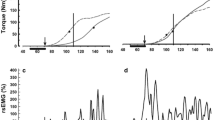Abstract
Unexpected loads, which often occur in the working environment, can lead to high forces in the spine and, thus, may be a cause of low back injury. This paper discusses the effect of “sudden load” on the erector spine reaction and amplitude. Muscle responses were mediated by several factors, including fatigue, posture, expectation and rehabilitation, in chronic low back pain patients. The subjects were fatigued by holding a 20% maximum voluntary contraction for 1 min. A functional restoration program was tested for its efficacy in reducing reaction time and EMG amplitude in chronic low back pain patients. Reaction time was longer and EMG amplitude lower in patients than in their matched controls. EMG reaction time and magnitude decreased in patients after a 2-week rehabilitation program, including specific training of coordination and posture control. The results of the modelling showed higher spinal compressive load and lower shear forces when the load was expected than when the load was unexpected. The effect of sudden loads can be exacerbated if a worker is not standing on a flat surface or is fatigued. Chronic low back pain patients have less ability to protect themselves from sudden loads, but they can be trained to improve their response by means of an appropriate rehabilitation program.
Similar content being viewed by others
References
Alaranta H, Moffroid M, Elmqvist L, Held J, Pope M, Renstrom P (1994) Postural control in adults with musculoskeletal impairment. Cri Rev Phys Rehabil Med 6:337–370
Allum JhJ, Hulliger M (1989) Afferent control of posture and locomotion; preface. Progr Brain Res 80:XV-XVII
Andersson GBJ (1981) Epidemiologic aspects on low-back pain in industry. Spine 6:53–60
Biedermann HJ, Shanks GL, Forrest WJ Inglis J (1991) Power spectrum analyses of electromyographic activity. Discriminators in the differential assessment of patients with chronic low-back pain. Spine 16:1179–1184
Cailliet R (1981) Low back pain syndrome. Davis, Philadelphia
Damkot DK, Pope MH, Lord J, Frymoyer JW (1984) The relationship between work history, work environment and low back pain in males. Spine 9:395–399
Frymoyer JW, Pope MH, Clements JH, Wilder DG, MacPherson B, Ashikaga T (1983) Risk factors in low back pain: An epidemiologic survey. J Bone Joint Surg [Am] 65:213–216
Horak FB, Nashner LM (1986) Central programming of postural movements: adaptation to altered support surface configurations. J Neurophysiol 55:1369–1381
Jayson MIV, Dixon ASTJ (eds) (1980) The lumbar spine and back pain. Pitman, London
Johansson RS, Westling G (1984) Roles of glabrous skin receptors and control of precision grip when lifting rougher or more slippery objects. Exp Brain Res 56:560–564
Lavender SA, Mirka GA, Schoenmarklin RW, Sommerich CM, Sudhakar LR, Marras WS (1989) The effects of preview and task symmetry on trunk muscle response to sudden loading. Hum Factors 31:101–115
Lavender SA, Marras WS, Miller RA (1993) The development of response strategies in preparation for sudden loading to the torso. Spine 18:2097–2105
Macnab I (1977) Backache. Williams and Wilkins, baltimore
Magnusson M, Wilder DG, Pope MH, Hansson T (1993) Investigation of the long-term exposure to whole-body vibration: 2-country study. Winner of the Vienna Award for Physical Medicine. Eur J Phys Med Rehabil 3:28–34
Magora A (1973) Investigation of the relation between low back pain and occupation. IV. Physical requirements: bending, rotation, reaching and sudden maximal effort. Scand J Rehab Med 5:186–190
Manning DP, Mitchell RG, Blanchfield LP (1984) Body movements and events contributing to accidental and nonaccidental back injuries. Spine 9:734–739
Marras WS, Rangarajulu SL, Lavender SA (1987) Trunk loading and expectation. Ergonomics 30:551–562
Molumphy M, Unger B, Jensen GM, Lopopolo RB (1985) Incidence of work-related low back pain in physical therapists. Phys Ther 65:482–486
Owen BD, Damron CF (1984) Personal characteristics and back injury among hospital nursing personnel. Res Nursing Health 7:305–313
Pope MH, Andersson GBJ, Chaffin D (1991) The workplace. In: Pope MH, Andersson GBJ, Frymoyer JW, Chaffin DB (eds) Occupational low back pain: assessment treatment and prevention 2nd edn. Mosby, St Louis
Schmidt R (1991) Motor learning and performance. From principles to practice. Human Kinetics Publishers, Champaign, Illinois
Taimela S, Osterman L, Kujala U, Lehto M, Korhonen T, Alaranta H (1990) Motor ability and personality with reference to soccer injuries. J Sport Med Phys Fitness 30:194–201
Taimela S, Osterman K, Alaranta H, Soukka A, Kujala UM (1993) Long psychomotor reaction time in patients with chronic low back pain: preliminary report. Arch Phys Med Rehabil 74:1161–1164
Thelen DG, Schultz AB, Fassois SD, Ashton-Miller JA (1994) Identification of dynamic myoelectric signal-to-force models during isometric lumbar muscle contractions. J Biomech 27:907–919
Author information
Authors and Affiliations
Rights and permissions
About this article
Cite this article
Magnusson, M.L., Aleksiev, A., Wilder, D.G. et al. European Spine Society —The Acromed Prize for Spinal Research 1995 Unexpected load and asymmetric posture as etiologic factors in low back pain. Eur Spine J 5, 23–35 (1996). https://doi.org/10.1007/BF00307824
Received:
Accepted:
Issue Date:
DOI: https://doi.org/10.1007/BF00307824




